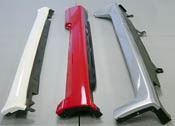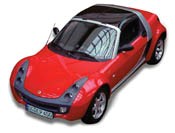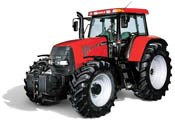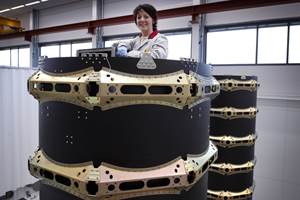In-Mold Decorating Dresses Up Composites
Automotive/industrial markets foster development of finishing techniques that eliminate costly paint lines.
Composite parts are decorated for a number of reasons. In most cases, the appearance of the part as it exits the mold lacks the desired surface smoothness, color, texture and/or other desirable characteristic. Some resins cannot survive years of exposure to ultraviolet light without fading, or worse, decomposing, so they require protective coatings. In other cases, finished products are assembled from parts made from a variety of plastic and metal subcomponents, which must be color-matched to achieve a uniform appearance.
By far, the most common method of decorating is post-mold painting, performed manually in a spray booth for small volumes, or on automated conveyer lines using paint robots and continuous flow ovens for high-volume parts, such as automotive body panels molded from sheet molding compound (SMC). While a post-mold coating can add value, improve aesthetics and extend the life of the part, it historically has added significant cost and an additional production step. By some estimates, painting and associated operations account for 30 to 50 percent of a part's cost and can be an enormous source of defects and scrap. Newer primers that seal molded-in porosity have gone a long way toward overcoming the scrap problem, but are often expensive and do nothing to satisfy concerns over volatile organic compound (VOC) emissions or reduce the high capital costs associated with installing and maintaining paint lines.
Coating the part in the mold is not a new idea, but until recently, had significant limitations. Liquid gel coats, applied prior to laminating in open molding, save a step, but create emissions issues and are generally only suitable for room-temperature application. In the past few years, however, several new options have emerged as practical alternatives to post-mold coating of composites, including, for the first time, the possibility of giving a Class A surface to long fiber-reinforced thermoplastic (LFRT) materials. Other techniques include the comolding of thermoformed multilayer thermoplastic "skins," the application of paint to the mold surface prior to molding and the application of a coating to a cured composite part while it is still in the mold.
Preformed films over LFRTs & PUs
Long fiber-reinforced thermoplastics (LFRTs) have been among the fastest growing of automotive materials over the past five years. Available in several forms, LFRT products contain reinforcement lengths of 10 mm/0.4 inch and longer, compared to traditional glass-reinforced thermoplastic compounds that use milled or short fibers (6mm/0.25 inch or less).
The longer reinforcement, with typical loadings of 30 to 50 percent by weight, provides a significant increase in impact strength and flexural modulus — up to twice that of short-fiber compounds with the same fiber percentage. With these advantages, LFRT materials are seeing increased use in structural and semistructural applications traditionally reserved for metals and thermoset composites. The higher shrinkage of the thermoplastic resin has deterred LFRT use in Class A automotive or other high-gloss applications, to date, so they have been employed where a grained or textured surface is either acceptable or desired.
This paradigm is being challenged as LFRT producers seek to expand into smooth exterior body panel applications by borrowing film technologies initially developed for metals laminating and for unreinforced thermoplastics produced by injection molding or thermoforming. Multilayer films, consisting of weatherable and colorable exterior skins over a tie layer compatible with the plastic injected behind it, offer a broad palette of colors and gloss levels that rival painted surfaces. The total thickness of this new generation of paint replacement films can be as low as 0.25 mm/0.010 inch. However, film and LFRT material suppliers point out that, for a composite, a thicker backing layer — likely two to three times thicker -- is needed to prevent fiber read through after molding. The manufacturing process typically entails vacuum forming the film to net or near-net part shape and trimming the film in separate processes, and then inserting it against the mold face prior to introduction of the LFRT substrate. The LFRT material is either compression or injection molded, where the composite resin melts to the carrier of the film. Film-insert molded finishes are reportedly often superior to painted finishes in terms of chip- and scratch-resistance.
Soliant LLC (Lancaster, S.C.) has been producing multilayer films for more than 15 years, initially for laminating to metallic substrates but more recently to plastics, explains Soliant's president Jerry Patton. "Because of our experience, we are one of the few companies able to offer a full palette of colors and match any pigment," he notes. Soliant's Fluorex paint film, available in widths up to 1.52m/60 inches, has a top layer of UV-resistant clear polyvinylidene fluoride (PVDF) mated with a hybrid acrylic color layer. The substrate can be one of several resins, including ABS (acrylonitrile butadiene styrene), ABS blends and polyolefins. The color layer can be any solid color or one of many metallics.
The key to making LFRT work with the decorative film is making sure the chemistry of the backing layer is compatible with the thermoplastic used in the glass-reinforced substrate, emphasizes Fred Deans, key accounts manager for Azdel Inc. (Southfield, Mich.). Azdel produces glass mat thermoplastic (GMT) sheet, which is traditionally compression molded. The company has successfully comolded polypropylene-based GMT and in-mold films, using a thermoplastic olefin (TPO, a polypropylene-based polymer) substrate, such as those supplied by Avery Dennison's Performance Films Div. (Troy, Mich.). Avery's Avloy film consists of a clear PVDF top layer followed by an acrylic color layer, a tie layer and then the substrate. The substrate is typically TPO, but ABS or polycarbonate also can be used.
Azdel also is working on mating Lexan SLX film, from parent company GE Advanced Materials (Pittsfield, Mass.), with its Azloy line of polycarbonate-based GMT products. Lexan SLX is a combination of a clear polyester carbonate top layer, over a color sheet of Lexan polycarbonate backed by a layer of Cycoloy polycarbonate/ABS blend. According to GE, the SLX film performs as well as OEM-specified paint systems, retaining over 95 percent of initial gloss after the equivalent of 10 years of Florida sun exposure. "The SLX adheres really well to Azloy, and provides an excellent surface finish," says Deans. Initial commercial applications are under development for late-2005 introduction in the outdoor appliance and construction industries, he notes.
Thermoformable paint films also are finding a home in thermoset composites, especially long fiber-reinforced polyurethanes, where temperatures and pressures, nominally 80oC/176oF and 7 bar/100 psi, are well below those used to process SMC and bulk molding compounds (BMC). Similar to LFRT decorating, the films are thermoformed, and then a precisely metered mixture of chopped fiberglass and polyurethane resin is pumped into the bottom cavity of a two-part heated mold. The mold is closed, applying pressure and, generally, after three to five minutes of cure time, the part can be removed from the mold. Referred to as Long Fiber Technology (LFT) or Long Fiber Injection (LFI), the technique's principal polyurethane resin suppliers include Bayer MaterialScience (Leverkusen, Germany and Pittsburgh, Pa.), and BASF subsidiary Elastogran GmbH (Olchingen, Germany).
Initial activity in the automotive industry has been focused on production of integrated roof modules, such as the removable hard top for the MCC smart roadster. Molded in two halves by Arvin Meritor (Gifhorn, Germany), the high gloss exterior finish is provided by a thermoformed Lexan SLX paint film with a total thickness of 1.3 mm/0.05 inch, backed by Bayer-supplied Baydur STR polyurethane in thicknesses ranging from 3.7 mm to 8 mm (0.15 inch to 0.30 inch). The headliner on the back side of the part is integrally bonded to the polyurethane at the same time. Following a seven-minute cure cycle and simple deflashing, the parts are ready for shipment to the assembly plant without further finishing steps.
Due to low tooling costs associated with LFT and LFI processing, low-volume markets, such as agricultural equipment, also are taking advantage of the process in conjunction with comolded paint films, notes Mike Reeves, sales director for Senoplast USA (Aurora, Ill.). From its facility in Piesendorf, Austria, Senoplast is supplying molder Parat Automotive (Remscheid, Germany) with senosan sheet for LFI molding of tractor parts. Case Corp. (Racine, Wis.), a major producer of farm equipment, turned to Parat to produce hoods for its CVX line of tractors. The three-piece hood, consisting of one horizontal and two vertical panels, features the senosan AM50 Solar sheet in Case's familiar red color. Produced in a nominal thickness of 3.0 mm/0.120 inch, senosan film features an acrylic top sheet with an ABS substrate. The company also produces higher temperature senotop, with a nominal 1.0-mm/0.040-inch thickness and an ABS/polycarbonate substrate.
While most applications of in-mold paint films involve two steps — thermoforming followed by comolding with the reinforcing compound — GMP Poliuretani SpA. (Oderzo, Italy) has designed a process, termed Foiled FiberPur Technology (FFT), that combines those steps. In the FFT process, a heated film is positioned over the mold cavity and vacuum formed directly against the mold surface, and then the polyurethane/glass mixture is immediately introduced. GMP also is producing parts for the agriculture industry, supplying a one-piece hood with integral paint film to BCS SpA., Divisione Ferrari (Luzzara, Italy) for the latter's Series 75 tractor. Because of the high stiffness provided by the glass reinforcement, the 1.0m by 1.0m by 0.6m (40 inch by 40 inch by 24 inch) hood weighs only 14 kg/31 lb.
Looking for the "wet" look
In many markets, smooth and/or glossy finishes are high priorities. Polyester resin-based gel coats are widely used in the composites industry to impart a smooth, paint-like colored surface to finished components. Drawbacks to gel coat include the need to apply a mold release (the films don't require them) the emission of VOCs, and a prolonged wait while the gel coat cures sufficiently to block fiber print-through, before laminate layers can be applied. For more than 20 years, manufacturers of open-molded composite shower surrounds, bathtubs and hot tubs have replaced gel coats with vacuum-formed, heavy-gauge acrylic sheets to provide attractive water- and chemical-resistant surfaces. These overcome the biggest drawbacks to gel coat, but still don't deliver the look and gloss one obtains by applying a paint basecoat and clear coat.
Taking a page from the in-mold film technology developed for thermoplastic molding, extruders of heavy-gauge sheet have developed multilayer systems for the industrial thermoforming and composites markets that accurately mimic clear-coated paint. Such sheets generally have a relatively thick base layer of a versatile plastic, such as ABS, co-extruded with one or more thinner top layers of UV-resistant plastics, one of which is a clear layer to impart gloss and depth. For lightly loaded components, this sheet can be simply vacuum formed and trimmed, but for structural products like boat hulls, the vacuum formed sheet is backed up with fiberglass composite, produced by either open molding or resin transfer molding (RTM).
A leading supplier of such multilayer sheets is Spartech Corp. (St. Louis, Mo.). The company's Weatherpro G is a three-layer, chemical- and UV-resistant sheet finding use in the hot tub and marine industries. A clear acrylic outer layer provides chemical- and scratch-resistance, as well as gloss and depth of image, giving the finished part a "wet" look similar to clear coats in automotive finishes. Just below the acrylic is a layer of Geloy XTW E290 acrylic-styrene-acrylonitrile (ASA), supplied by GE Advanced Materials. A base layer of GE's Cycolac ABS provides overall structure and a material that bonds well with polyester resins. According to GE, the new Geloy plastic provides three to five times the weatherability of traditional ASA resins, based on laboratory tests.
Great Lakes Home and Resort (Holland, Mich.) is using the multilayer sheet in a premium line of hot tubs, citing reductions in clouding, fading and cracking, three common flaws found in traditional acrylic hot tub surfaces. The company touts the finish as a real showroom draw, offering six colors in late 2004, with another dozen slated for introduction some time this year.
Another significant user of the Weatherpro G sheet is Genmar Holdings Inc. (Minneapolis, Minn.). Thermoformed to near-net shape and inserted into the mold as a gel coat replacement on Genmar's Four Winns, Glastron and other recreational boat lines, the sheet significantly reduces layup time and, combined with the company's patented Virtual Engineered Composites (VEC) closed-mold RTM process, eliminates more than 90 percent of all styrene emissions associated with traditional open molding of boat hulls. The Weatherpro G finish reportedly provides superior resistance to osmostic blistering, compared to gel coats, and Genmar has found that the multilayer sheet reduces the fiberglass reinforcement required to achieve the same overall stiffness in the hull.
Paint it in the mold
High-temperature composite molding processes discourage the use of thermoplastic films or multilayer sheets. In the injection or compression molding of BMC or SMC, temperatures are typically in the range of 138°C to 177°C (280°F to 350°F). Therefore thermoformed films would have to be inserted into the mold cavities preheated to temperatures well above that desired for maintaining their dimensional stability. More significant, the large differences in coefficients of thermal expansion (CTEs) between highly filled BMC/SMC and the unfilled polymer films create large stresses on the interface as the molded parts cool to room temperature or below. This can cause the films to delaminate from the composite substrate. While several film producers are trying to develop improved tie layers that could dissipate such stresses, they've met with little success to date. In the absence of film-based solutions, several companies have taken a different approach. Instead of performing this operation after demolding, why not paint it before molding or while the part is still in the mold? The powder coatings division of Rohm and Haas (Philadelphia, Pa.), for example, supplies INCOTE 29000 Series polyester powders for bath fixtures compression molded from SMC and BMC. A 100 percent solids system with a melting point of 55°C/131°F, the powder is sprayed onto the hot mold surface, where it flows and gels quickly. The SMC or BMC charge is then loaded and compressed, bonding tightly to the coating during normal cure. When applied at a nominal thickness of 0.075 mm to 0.150 mm (0.003 inch to 0.006 inch), the thermoset coating, used for lavatories, bathtubs and shower stalls, has a high hardness and is resistant to staining and abrasion.
Another option, with SMC, is to paint the part after cure but prior to demolding. Sherwin Williams Corp. (Cleveland, Ohio) has long supplied in-mold coatings under the Polane "Glas Clad" tradename. To date, these have been gray or black conductive primers, designed to minimize surface porosity prior to conventional paint finishing. At the end of cure of the composite substrate, the press tonnage is relaxed, and the coating is injected over the surface of the part at a thickness of 0.075 mm to 0.125 mm (0.003 inch to 0.005 inch). After the coating is cured, the part is demolded. While useful in reducing emissions associated with a first priming step, such in-mold coatings do not yield a finished color coat.
Currently in field trials, however, is a new in-mold coating system designed to provide the color basecoat, explains Jim Rayle, national manager of sales and technical service for Sherwin Williams. Targeted initially at the heavy truck market, the system consists of two parts: an in-mold color coating injected and cured in the typical fashion, and a low-VOC clear coat, sprayed in the final finishing step and cured. A "touch up" by hand is performed around the edges of cutouts and drilled holes between molding and clear coating. While the system does not eliminate post-mold painting entirely, it frees up considerable finishing capacity and avoids the need for additional capital investment, Rayle notes.
Molders of polyurethane composites also are taking advantage of in-mold coating. Since the late 1980s, GI Plastek (Newburyport, Mass.) first employed and refined its in-house-developed ProTek technology in conventional reaction injection molding (RIM) and reinforced RIM (RRIM) processes. In recent years, Protek was adapted to both LFT processing and structural RIM (SRIM, which involves injection of urethane into a fiber preform in a closed mold). The ProTek formulation consists of a 100 percent solids aliphatic triisocyanate/polyol coating sprayed onto the mold surface, followed by molding of a formulated aromatic diisocyanate/polyol composite. As both systems employ urethane chemistry, there is crosslinking between the coating and substrate, providing a durable, smooth surface. The use of an aliphatic system for the exterior provides superior UV resistance. According to the company, Pro-Tek coatings can be virtually any color and are ideally suited for parts that require minimal post-mold machining. GI Plastek also has used the system to apply multiple colors in the same mold and to apply a clear topcoat, followed by a color basecoat prior to molding.
While most in-mold coating technologies have targeted glossy or smooth surfaces, the technique also is applicable for textured parts and those meant to disguise the rugged composite underneath. Romeo RIM (Romeo, Mich.) uses polyurethane LFT technology from Bayer to produce panels of various sizes for the interiors of Freightliner's LLC Century Class heavy truck. Prior to the application of the glass composite material, a "soft-touch," two-part polyurethane paint is applied to the textured mold surface and co-cured with the substrate, yielding a finished part upon molding that is about 25 percent lighter than previous parts produced in a structural foam process.
Market drives progress
While post-mold painting isn't headed for extinction, look for in-mold decorating to grow at a rapid rate, as innovators continue to develop these technologies. Quadrant Plastic Composites AG (Lenzburg, Switzerland) has proposed marrying coil-coated aluminum sheet with Quadrant's Symalit low-density glass mat thermoplastic to form relatively flat panels with high structural strength and stiffness but low weight. Such combinations might include automobile roof panels, liftgates and panels for travel trailers, suggests Marcia Kurcz, a marketing representative for Quadrant in Detroit, Mich.
Painted surfaces are not the only targets for in-mold decorating. Quadrant is also pursuing films that incorporate a vinyl or fabric surface layer, laminated to a Symalit GMT substrate, for vehicle interior components. Nor is the in-mold process for LFRT limited to compression molding. Ticona Inc. (Louisville, Ky.) is seeking final approvals for semi-structural door modules that combine the high rate injection molding process with Ticona's Celstran long-fiber glass-reinforced polypropylene pellets, explains Maria Ciliberti, automotive regional sales manager. Aimed at automotive and commercial truck markets, the door modules feature large areas fronted by Avery Dennison's Avloy film, with a wood grained color ply under the clear top layer.
Down the road, look for a host of new textures, colors and special effects in future paint-replacement films and sheet stock, with greater variety in in-mold painting as well.
Related Content
Plant tour: Albany Engineered Composites, Rochester, N.H., U.S.
Efficient, high-quality, well-controlled composites manufacturing at volume is the mantra for this 3D weaving specialist.
Read MoreFrom the CW Archives: Airbus A400M cargo door
The inaugural CW From the Archives revisits Sara Black’s 2007 story on out-of-autoclave infusion used to fabricate the massive composite upper cargo door for the Airbus A400M military airlifter.
Read MoreMaterials & Processes: Tooling for composites
Composite parts are formed in molds, also known as tools. Tools can be made from virtually any material. The material type, shape and complexity depend upon the part and length of production run. Here's a short summary of the issues involved in electing and making tools.
Read MoreRUAG rebrands as Beyond Gravity, boosts CFRP satellite dispenser capacity
NEW smart factory in Linköping will double production and use sensors, data analytics for real-time quality control — CW talks with Holger Wentscher, Beyond Gravity’s head of launcher programs.
Read MoreRead Next
Composites end markets: Energy (2024)
Composites are used widely in oil/gas, wind and other renewable energy applications. Despite market challenges, growth potential and innovation for composites continue.
Read MoreFrom the CW Archives: The tale of the thermoplastic cryotank
In 2006, guest columnist Bob Hartunian related the story of his efforts two decades prior, while at McDonnell Douglas, to develop a thermoplastic composite crytank for hydrogen storage. He learned a lot of lessons.
Read MoreCW’s 2024 Top Shops survey offers new approach to benchmarking
Respondents that complete the survey by April 30, 2024, have the chance to be recognized as an honoree.
Read More






















.jpg;maxWidth=300;quality=90)











